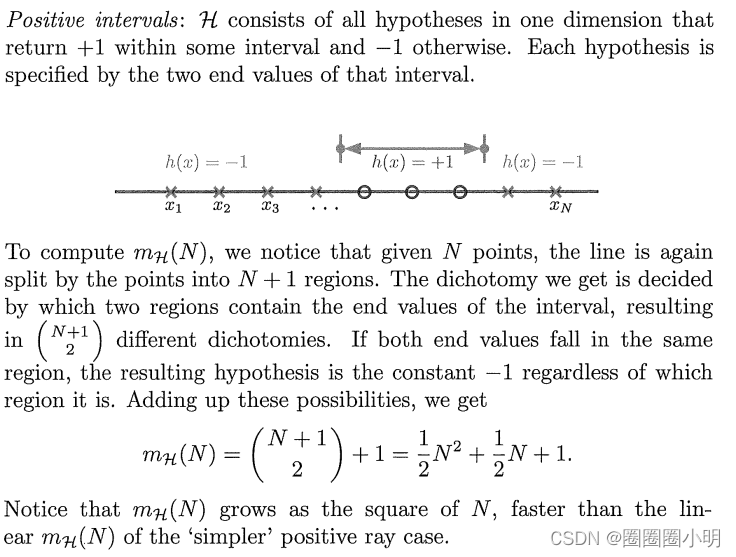 GPT的解释:
GPT的解释:
这段话解释了在一维中,针对 "Positive intervals"(正间隔)假设类别 H 的成长函数 mq(N) 的计算方式,以及如何得出这个成长函数。
1. "Positive intervals" 指的是一维情境中的假设,每个假设都由一个区间内的数据点返回 +1,而区间之外的点返回 -1。每个假设由该区间的两个端点来指定。
2. 当给定 N 个点时,这些点将一维空间分割成 N+1 个区域。每个区域由两个相邻的点之间的部分定义。
3. 对于每个区间的假设,我们需要考虑两个端点落入哪两个相邻的区域。这会导致 (N+1)/2 种不同的分割方式(dichotomies)。这是因为第一个端点有 N+1 种选择,但第二个端点必须与第一个端点所在的区域不同,所以有 (N+1)/2 种不同的组合。
4. 如果两个端点都落在同一个区域,那么假设将始终是常数 -1,不管是哪个区域。
5. 将这些可能性相加,我们得到成长函数 m_H(N) 的表达式:
m_H(N) = ((N+1)/2) * |interval ends in N+1 spots| + 1 * |all x|
这里 |interval ends in N+1 spots| 表示端点落在不同区域的数量,|all x| 表示两个端点都在同一个区域的数量。
6. 最后,计算这个表达式,得到 m_H(N) = (1/2) * N^2 + (1/2) * N + 1。这是在给定 N 个点时 "Positive intervals" 假设类别 H 的成长函数。
总结:这段话解释了如何计算在一维情境中 "Positive intervals" 假设类别 H 的成长函数 mq(N),并展示了成长函数的计算方式。其中,(N+1)/2 表达了端点落在不同区域的数量,它是根据给定的 N 点来计算的。最后,它提到 mq(N) 增长速度较快,与较简单的 "positive ray" 情况的线性 mq(N) 不同。
第五步到第六步是如何推导出来的?
第五步到第六步是通过将第四步中的不同情况的数量代入第五步的表达式来推导出来的。我将详细解释这个推导过程:
在第四步中,我们得到了成长函数 m_H(N) 的表达式:
m_H(N) = ((N+1)/2) * |interval ends in N+1 spots| + 1 * |all x|
其中,|interval ends in N+1 spots| 表示端点落在不同区域的数量,|all x| 表示两个端点都在同一个区域的数量。
现在,我们将计算这两种情况的数量,并将它们代入表达式中:
1. **端点落在不同区域的数量**:根据前面的解释,在 N 个点的情况下,两个端点可以以 (N+1)/2 种不同的方式分布在不同的区域,因为第一个端点有 N+1 种选择,但第二个端点必须与第一个端点所在的区域不同。所以,|interval ends in N+1 spots| = (N+1)/2。
2. **两个端点都在同一个区域的数量**:这表示两个端点都在 N+1 个区域中的同一个区域内。由于有 N+1 个区域可供选择,所以 |all x| = N+1。
现在,我们将这两个数量代入成长函数的表达式:
m_H(N) = ((N+1)/2) * |interval ends in N+1 spots| + 1 * |all x|
m_H(N) = ((N+1)/2) * ((N+1)/2) + 1 * (N+1)
继续计算:
m_H(N) = ((N+1)^2)/4 + (N+1)
最后,将 ((N+1)^2)/4 展开并将其与 (N+1) 相加,得到最终的表达式:
m_H(N) = (1/2) * N^2 + (1/2) * N + 1
这就是从第五步到第六步的推导过程,其中我们计算了不同情况的数量并代入成长函数的表达式,以得到最终的成长函数表达式。




















 1776
1776











 被折叠的 条评论
为什么被折叠?
被折叠的 条评论
为什么被折叠?








